

Touch & Movement Therapies
Touching, Rubbing & Stroking are instinctive gestures of comfort, and human contact can have strong physiological as well as emotional effects.
Massage Therapy
|
Massage has been used for thousands of years as a simple and effective method of attaining and maintaining good health, and its benefits have long been recognized in many cultures throughout the world. Therapeutic massage can be used to promote general well-being and enhance self-esteem, while boosting the circulatory and immune systems to benefit blood pressure, circulation, muscle tone, digestion, and skin tone. It has been incorporated in into many health systems and different massage techniques have been developed and integrated into various complementary therapies.
Reflexology
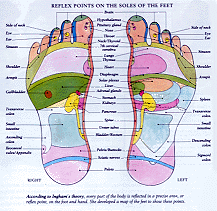
Foot massage has been practiced for centuries, but reflexologists believe that it can do more than simply aid relaxation. According to reflexologists, the feet and hands are a mirror of the body, and pressure placed on specific reflex points on them can be used to affect the corresponding areas of the body in order to stimulate natural healing powers and promote well-being. All parts of the foot (or, less commonly, the hand or ear) are massaged, so that the whole body benefits. the therapy has become popular around the world, and is often used in conjunction with aromatherapy or naturopathy.
Aromatherapy

Many cultures, from Far Eastern to Ancient Egyptian, have established a form of aromatherapy over the centuries, combining the medicinal properties known to exist in plants with the tradition of healing massage with oil. Modern aromatherapy practice is largely based on research by doctors in France, where essential oils are sometimes prescribed as alternatives to conventional medicine. Outside France, aromatherapy initially became popular as a beauty treatment, and its medicinal and therapeutic potential has only recently been recognized.
Chiropractic
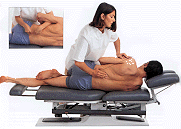
Developed in the late 19th century by Daniel D. Palmer, chiropractic seeks to diagnose and treat disorders of the spine, joints, and muscles with techniques of manipulation, and to maintain the health of the central nervous system and organs. Practitioners believe that when body systems are in harmony, the body has the ability to heal itself from within. As a result of its success in treating back problems, headaches, and sports and other injuries, chiropractic is the most widely practiced branch of complementary medicine in the West, with around 60,000 practitioners worldwide.
Osteopathy

This holistic approach to diagnosis and treatment originated in the United States in the late 19th century. Practitioners use touch and manipulation of the musculoskeletal system to restore or improve mobility and balance, and thereby enhance well-being. Techniques range from gentle massage to high-velocity mobilization of the joints. Now established along conventional medicine in North America, and practiced throughout Europe and Australia, osteopathy is one of the most respected and widely used complementary therapies, particularly for a pain in the back and joints.
Cranio Sacral Therapy
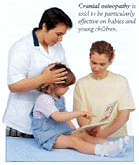
Cranial Sacral Therapy is a diagnostic and healing approach based on the application of corrective pressure to the cranium and spine (the cranio-sacral system). It grew out of work with cranial osteopathy in claiming that the cranial rhythmic impulse affects every cell in the body. Dr. John Upledger, an osteopath at Michigan State University, developed this approach in the late 1970s. While incorporating some of the techniques practiced in cranial osteopathy, Upledger distinguishes it from osteopathy in being "soft tissue-oriented", "fluid-oriented", and "membrane-oriented" rather than "bone-oriented". The approach is still considered controversial in the UK, though more widely practiced in the US.
Acupuncture

The meridians of the body
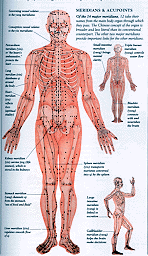
Part of traditional Chinese medicine, acupuncture has been practiced in China for thousands of years. It became widely known in the West in the 1970s when it was used as an anesthetic and received sensational press coverage. Practitioners insert fine, sterile needles into specific points on the body as a treatment for disorders ranging from asthma to alcohol addiction, but most often as a means of pain relief in the West. Now one of the most well-known and most widely accepted Eastern therapies, acupuncture is increasingly practiced in a simplified form my medical doctors. The theory is that Qi, an invisible life energy, flows through yin and yang meridians just below the surface of the skin. Any disruption to the flow disturbs the balance of yin and yang and leads to illness.
Electro-Acupuncture
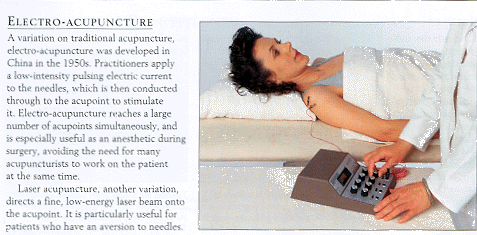
Acupressure
Described as "acupuncture without needles", acupressure probably predates its better known sister therapy. Part of Traditional Chinese Medicine, it is based on the theory of Qi (life energy) flowing through channels in the body known as meridians. Finger and thumb pressure is applied to acupoints to relieve specific conditions and to promote harmony and good health. Widely practiced in China, acupressure is less common in the West, but is gaining popularity. Many acupuncturists use acupressure as part of treatment, and claim it is suitable for self-treating minor ailments.
T'Ai Chi Ch'uan

Often known as T'AI CHI, this Chinese movement therapy was reputedly practiced by Taoist monks in the 13th century, but its exact origins are difficult to trace. A dynamic form of Qigong, T'ai chi is a non-combative martial art that uses breathing techniques and sequences of slow, graceful movements to improve the flow of Qi or "life energy", calm the mind, and promote self-healing. T'ai chi is often described as meditation in motion and is performed daily by millions of Chinese people all over the world. Its popularity is increasing in the West.
Yoga
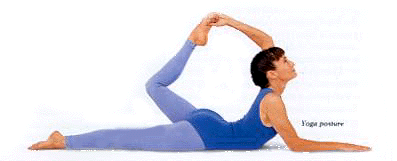
Yoga asanas and relaxation techniques were developed to bring physical and spiritual benefits. Asanas are designed to have an impact on the physical body, stimulating nerve centers and organs. Spiritual benefits are derived from using breathing techniques and meditation to influence the flow of prana, or life energy, which flows through the "subtle" (nonphysical) body in invisible "energy channels", known as nadi. When mind and body are in harmony, the individual can focus on spiritual goals by practicing the higher discipline of meditation.
CHAKRAS

In more esoteric yoga teachings, the chakras are centers of life energy, situated in the "subtle body" - seat of the senses, emotions, and intellect. Seven chakras ascend in order of spiritual refinement along a central channel, the Sushumna. Chakras are linked to nerve centers along the spinal cord and, like them, are thought to be influenced by asanas. Each chakra is symbolized by an exact number of lotus petals and, according to some schools of yoga, is associated with a specific mantra or sound, such as "Om" or "Ram". These are used in meditation and breathing exercises to act on the chakras.
Other Therapeutic Disciplines:
Shiatsu
Qi Gong
Polarity Therapy
Therapeutic Touch
Reiki
Healing
Dance Movement Therapy
Medicinal Therapies
Homeopathy
Bach Flower Remedies
Western Herbalism
Chinese Herbalism
Ayurveda
Magnetic Therapy
Crystal Therapy
Nutritional Therapies
Mind and Emotion Therapies
Psychotherapy
Hypnotherapy
Astrological
Counseling
Bio Feedback
Diagnostic Techniques
Hara Diagnosis
Hair Analysis
Kirlian Photography